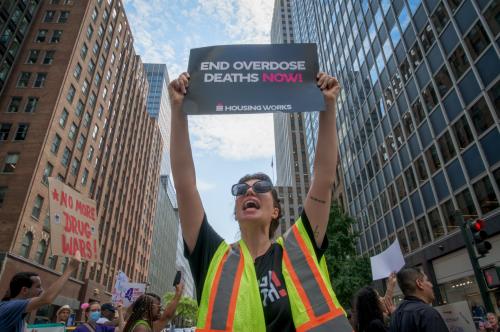As explained in our previous commentary, the Inflation Reduction Act (IRA) of 2022 included a number of provisions to reform how the federal Medicare program pays for prescription drugs (encompassing both small-molecule drugs and biological products) for its beneficiaries. One key provision of the IRA was the creation of a Medicare drug price negotiation program, allowing Medicare to negotiate a “maximum fair price” (MFP) directly with drug manufacturers for a limited number of qualifying single-source drugs each year. The IRA calls for the first set of negotiated prices to take effect in 2026, and the Centers for Medicare and Medicaid Services (CMS) recently completed the negotiation process for the first set of drugs and published its explanations for each of the negotiated MFPs. In January, CMS announced the second set of drugs selected for the negotiation program, with any negotiated prices taking effect in 2027.
In the 2026 and 2027 cycles of the program, the IRA instructed CMS to limit the negotiation program to high-expenditure drugs covered under Medicare Part D. In the 2028 cycle, the IRA expands the program to include high-expenditure drugs covered under Medicare Part B, in addition to those covered under Part D. This expansion to include Part B may pose policy, economic, and operational challenges for CMS, as they relate to potential data requirements and the prescription drug supply chain. As CMS develops guidance for the 2028 cycle of the program, we examine three key sets of issues CMS is likely to face in implementing and operationalizing this expansion, offering policy suggestions for agency officials.
Operationalizing the scope of the drug
One operational issue for CMS in its implementation of the negotiation program is how to identify the appropriate scope of the relevant “drug” for inclusion in the negotiation program. Consistent with the statute, CMS’ guidance1 defines a potential qualifying single-source drug to include “all dosage forms and strengths of the drug with the same active moiety and the same holder of a New Drug Application (NDA), inclusive of products that are marketed pursuant to different NDAs.” CMS applies an analogous definition for biological products, to include “all dosage forms and strengths of the biological product with the same active ingredient and the same holder of a Biologics License Application (BLA), inclusive of products that are marketed pursuant to different BLAs.” These definitions follow directly from several statutory instructions to CMS, including Section 1192(d)(3)(B)’s instruction to CMS to use “data that is aggregated across dosage forms and strengths of the drug, including new formulations of the drug, such as an extended release formulation, and not based on the specific formulation or package size or package type of the drug” for purposes of determining whether a qualifying single-source drug is eligible for the negotiation program.
One important reason for Congress to have intended CMS aggregate across dosage forms and strengths would have been to reduce incentives for manufacturers to try to define their products narrowly (e.g., by dosage strength or by form, such as tablets versus capsules). A related practice that is curtailed by the definition is “product hopping,” in which a manufacturer could apply for a new NDA or BLA on the basis of minor changes to the formulation of their product, particularly in a way that does not benefit patients in terms of increased efficacy or safety, and avoid selection for the negotiation program on that basis. Congress’ specific reference to extended release formulations of products is relevant here, as several notable “product hopping” incidents have involved extended release formulations. Enabling manufacturers to avoid selection for the negotiation program on the basis of minor or modest reformulations would be opposed to Congress’ intent. Further, because drugs are selected for inclusion in the program on the basis of total expenditures, allowing manufacturers to fragment spending across multiple NDAs or BLAs (or even within a single NDA or BLA) could create a race among manufacturers to split spending for their products so that none rise to the top of the total expenditure list. Indeed, the Congressional Budget Office has stated that its estimate of the savings to be achieved from the negotiation program “incorporate[d] the expectation that CMS will negotiate drug prices on the basis of a drug’s active ingredient instead of its trade name or approval date,” as CMS has done. CMS ought to retain this definition moving forward.
Importantly, though, any method CMS would have adopted to identify the scope of the relevant “drug”—this or a narrower one—would likely face operational and data-related challenges in expanding the negotiation program to Medicare Part B. We describe three challenges specific to identifying the scope of the relevant “drug” and offer proposals for agency officials’ consideration. In the background of these legal and operational issues are a series of financial incentives that manufacturers, physicians, and pharmacies have.
Obtaining the necessary spending data for selecting drugs
For the 2026 and 2027 cycles, CMS was able to calculate total expenditures under Part D for qualifying single-source drugs using Prescription Drug Event (PDE) data at the 11-digit National Drug Code (NDC-11) level.2 Existing Food and Drug Administration (FDA) and CMS data sets enable CMS to both identify each NDC-11 associated with a particular drug and attribute spending to each NDC-11, which can then be summed together to result in total expenditures for the relevant qualifying single-source drug.
However, Part B reimbursements are based on a different system—the Healthcare Common Procedure Code System (HCPCS)—which does not permit spending information to be gathered at the NDC-11 level.3 As a result, the existing structure of the HCPCS system may pose operational challenges for CMS in obtaining the spending information necessary to determine which drugs should be selected for participation in the program. To be sure, in most cases, the structure of the HCPCS code will map to CMS’ definition of the scope of the relevant qualifying single-source drug for purposes of the negotiation program, such that even if CMS cannot determine which NDC-11s drove the majority of spending under Part B, the agency can still determine the total expenditures for the relevant drug. But in some cases, a HCPCS code will include multiple qualifying single-source drugs, such that looking at spending under that HCPCS code will overcount spending attributable to one particular drug. For example, a branded drug and its therapeutically equivalent small-molecule generics will be grouped together under one HCPCS code, with the reimbursement amount reflecting a weighted average of their prices. (To be sure, a branded drug with generic equivalents that have been approved and marketed is not eligible for selection into the negotiation program, but these codes may be important to the negotiation process in terms of identifying the prices of therapeutic alternatives, as discussed below.)
CMS has several options to address this potential issue, though in assessing which (if any) option the agency pursues, it will first be important to identify the scope of the problem. The most immediate concern is whether the problematic HCPCS codes are associated with the potential set of selected drugs. For example, if the affected codes only apply to drugs ineligible due to the duration of time since approval, the type of manufacturer selling the product, or the inclusion of generic equivalents, then developing a new approach to the assembly of relevant data can be considered over a longer timeline than the 2028 cycle.
If there are potentially problematic HCPCS codes, there are a number of possible policy options for CMS to consider. One option would be to use apportionment, as CMS already did in certain circumstances for the 2026 and 2027 cycles. That is, for purposes of determining the low-spend Medicare drug exclusion, in “cases where a potential qualifying single-source drug is assigned to a HCPCS code with other products,” CMS used “Average Sales Price (ASP) sales volume data to apportion Part B expenditures based on the ratio of reported sales volume of the potential qualifying single-source drug compared to reported sales volume of all products assigned to the HCPCS code to calculate the Total Expenditures under Part B.”4 In this case, CMS could apportion Part B expenditures in the same way to obtain the total expenditure data needed at the selection stage of the process.
A second option would be for CMS to redesign the HCPCS codes to allow them to more precisely serve this function. Ideally, each HCPCS code would be “scoped” or designed not only to allow CMS to gather the expenditure data needed at the selection stage but also to apply any resulting MFP, a topic explored below. A related question, also explored below, would be whether the overlap of the need to identify not only the drug product but also the participating manufacturer would impact the HCPCS redesign. This is a significant undertaking, and it may be most practical for CMS to, in the short and medium term, prioritize analyzing and possibly redesigning the HCPCS codes containing drugs which are potential qualifying single-source drugs. We also recognize that it may already be too late for CMS to implement this proposal to aid the agency in selection for the 2028 cycle of the program, given that selection for the 2028 cycle will depend in part on expenditure data from prior years. It may, however, be well-timed for application of any negotiated MFP for the 2028 cycle, and thus, redesign could focus on the HCPCS codes at issue for the selected drugs.
Analyzing the applicable spending data for selecting drugs
Most drugs have Medicare expenditures under only Part B or Part D. Some drugs, however, have expenditures under both Parts B and D. This raises the question of how should CMS treat such products in the 2028 cycle of the program if any drugs with expenditures under both Parts are selected? The existence of individual drug products whose expenditures span Parts B and D poses potential challenges at multiple stages, including selecting drugs for the negotiation program and performing the negotiation itself (as analyzed below).
At the selection stage, on their face, two provisions of the statute might appear to be in conflict. Under Section 1192(d), status as a negotiation-eligible drug depends on whether a qualifying single-source drug is a top-50 “Part D high spend drug” or a top-50 “Part B high spend drug,” with Part D high spend drugs determined by total expenditures under Part D and Part B high spend drugs determined by total expenditures under Part B. However, in actually selecting drugs for participation in the negotiation program, starting with the 2028 cycle, Section 1192(b) instructs CMS to rank negotiation-eligible drugs “according to the total expenditures for such drugs under parts B and D” and to select the applicable number of the highest such ranked drugs. One possible implication of these two sections is that CMS might identify negotiation-eligible drugs on the basis of their spending under either Part B or D (that is, a negotiation-eligible drug must be a top-50 high spend drug within either Part B or D), but, in ultimately ranking the drugs for selection of the top applicable drugs, CMS would add the Part B and D expenditures for a particular drug together in creating that ranking.
An interpretation of the statute that allowed manufacturers to fully separate out their Part B and D expenditures at the selection stage of the process would have concerning effects from a manufacturer gaming perspective. Such an interpretation would give manufacturers new incentives to try to shift spending for drugs between Parts B and D, if they believed that doing so would help them evade selection for the negotiation program or would otherwise have a benefit to them during the negotiation process. Congress’ apparent instruction to make status as a negotiation-eligible drug turn on high spend status under either Part B or D is consistent with this interpretation. That is, it would be more difficult for manufacturers to apportion their spending between Parts B and D in order to avoid being in the top-50 high spend drugs under each program than to apportion their spending to avoid being in the top-15 high spend drugs (for 2028, and 20 such drugs in subsequent years), were the two to be considered separately.
Considering the role of the manufacturer
As noted above, CMS’ process for defining and identifying potential qualifying single-source drugs includes not only considering the product’s active moiety or active ingredient, but also whether all such dosage forms and strengths have the “same holder” of either a NDA or BLA. That is, if there were two separate NDAs or BLAs associated with a particular active moiety or active ingredient and they were held by different manufacturers, CMS would consider those to be separate qualifying single-source drugs for the purposes of the negotiation program. Or, for example, if another entity were to meet the statutory definition of “manufacturer”5 and were to operate as a repackager or relabeler of the product in question, CMS has articulated the circumstances under which the Primary Manufacturer—the one who holds the NDA or BLA—would have obligations extending toward any other such manufacturers.
It is conceivable that this question—of what the drug is, but also who its manufacturer is—will also arise in the expansion to Part B and the scope of a particular HCPCS code. If a particular HCPCS code includes situations in which the drug is “manufactured” (using the statutory definition) by an entity other than the Primary Manufacturer, CMS may again experience operational challenges in determining the scope of the relevant qualifying single-source drug. As mentioned above, CMS may wish to consider this additional factor when contemplating a redesign of the relevant HCPCS codes. CMS may wish to determine if there are situations in which non-Primary Manufacturers are involved in the “manufacturing” and distribution of the relevant active ingredients and active moieties and may wish to scope the revised HCPCS codes not only at the level of the relevant drug product but also by reference to the identity of the manufacturers involved.
Issues arising during the negotiation process
We describe three challenges related to the inclusion of Medicare Part B drugs likely to arise during the process of negotiation itself, related to defining the ceiling, the use of therapeutic alternatives, and the application of any negotiated MFP, and offer proposals for agency officials’ consideration.
Defining the ceiling
The negotiation program statute identifies a “ceiling” for the MFP, and CMS may not offer (or agree to a counteroffer) above this point. The ceiling is defined in the statute as “the lower of” two numbers. One of these numbers is a particular percentage off of the relevant average non-Federal average manufacturer price. The other number, though, may be more complicated in a situation involving drugs with expenditures under both Parts B and D. That is, the statute specifies that for a “covered Part D drug,” the other ceiling input is “the sum of the plan-specific enrollment weighted amounts for each” plan. For “Part B drug[s],” though, the other ceiling input is the relevant Part B reimbursement amount, likely to be the ASP. For a drug with expenditures under both Parts, how should CMS determine the ceiling?
CMS could justify a range of interpretive approaches for such drugs. Some such approaches would apply one formula to the exclusion of the other. As noted above, status as a negotiation-eligible drug under Section 1192(d) depends on high spend drug status under either Part B or Part D, even though selection would be based on total expenditures under both B and D. One option would be for CMS to choose to use the applicable ceiling metric, and link the drug’s negotiation eligibility and the ceiling calculation. Other statutory readings might rely on the fact that a drug with expenditures under both programs is, by definition, both a “covered Part D drug” and a “Part B drug or biological.” One, but not the only, option would look to combine the relevant formulae, such as taking a weighted average approach of both Part D and Part B metrics.
Use of therapeutic alternatives
In determining the starting point for each initial offer, the 2027 guidance notes that CMS will consider not only the prices of the relevant therapeutic alternatives (including generic and biosimilar therapeutic alternatives), but also “the utilization of each therapeutic alternative relative to the selected drug.” It is possible that the practical impact of this approach is to establish a higher starting point in the context of a drug with biologic therapeutic alternatives that have biosimilar competition than in the context of a drug with small-molecule therapeutic alternatives that have generic competition because biosimilar uptake remains low. Placing significant emphasis on the price of a reference biologic therapeutic alternative when lower-priced biosimilars of that reference product are approved and marketed would bake in the existing challenges of our system in encouraging biosimilar competition, and benefits (with a higher starting point) biologics manufacturers for their ability to discourage use of biosimilars. Those patterns can be expected to evolve over time.
Most of the selected drugs for the 2026 and 2027 cycles of the program are small-molecule drugs with small-molecule therapeutic alternatives, though some selected drugs are biologics or are small-molecule drugs with biologic therapeutic alternatives. As the program expands to include drugs covered under Part B, though, it is more likely that the program will expand to include a greater number of biologic drugs with biologic therapeutic alternatives, meaning that this issue will become more relevant. More generally, to the extent that there is less price competition between branded products in Part B (when compared to Part D) due to the different structure of the benefit and types of drugs used in the programs, CMS may find that the use of prices of the therapeutic alternatives for Part B products is more likely to result in a starting point above the ceiling.
Instead, CMS might consider whether another approach is more reflective of the price discounts available in the biosimilar context and make greater use of the price of competing biosimilars.
Applying any negotiated MFP
CMS will need to apply any negotiated MFP across dosage forms and strengths of the drug. In applying a negotiated MFP in Part B, CMS will face the same operational challenges regarding the design of a HCPCS code that CMS faced in obtaining and analyzing the necessary spending data at the selection stage of the negotiation program. As noted above, it may not be feasible for CMS to redesign the relevant HCPCS codes in time for selection for the 2028 cycle of the negotiation program. However, once CMS selects (in early 2026) the relevant drugs for participation in the 2028 cycle of the program, the agency will have sufficient time to redesign the HCPCS codes at issue for application of any negotiated MFP beginning in 2028.
Ensuring drug availability and patient access
A central feature of existing prescription drug payment arrangements that differentiates Part B from Part D is Part B’s reimbursement of physicians and clinics on the basis of the ASP of a drug calculated using the average of net prices paid by all payers plus an add-on of 6% (now 4.3%, after sequestration) of the ASP. This payment design contains some important incentives that both affect physician choice of therapeutic agents and drive certain competitive dynamics that are important to consider in negotiation program guidance. These incentives have the potential to promote physicians and clinics to increase the prescribing of non-selected drugs as compared to selected drugs in some circumstances, resulting in impacts not only for patient access but also on whether the negotiation program is ultimately able to lower drug spending. Here, we examine these incentives, identify the situations under which they are likely to be more or less salient for a particular drug, and offer some policy options for CMS to consider.
The reimbursement approach of paying ASP + 6% under Part B rewards physicians and clinics with higher add-on payments when they choose to administer more expensive drugs. In addition, many outpatient clinics that deliver provider-administered drugs are currently eligible for deep discounts on the acquisition costs of Part B-covered drugs through the 340B program; however, these discounts are not required to be passed onto payers or patients. Likewise, physician practices can make profits by purchasing product at a price lower than ASP and being paid ASP + 6%, as they are permitted to keep the difference. These payment arrangements diminish the incentives for therapeutic choices to be made on the value of the product. The empirical evidence in the oncology area shows that physicians act on these incentives and choose higher cost and high margin products.
Under the negotiation program, if a drug covered under Part B is selected for inclusion in the Program and its manufacturer negotiates an MFP, these reimbursement structures change. Physicians would then be reimbursed at MFP + 6%. If the negotiation program results in an MFP significantly lower than the current ASP, the dollar value of the percentage add-on also falls, and the product becomes less attractive for a physician or clinic to deliver, and they may substitute away from the selected drug, choosing to prescribe a non-selected drug in its place. Importantly, the selected drug will still be covered under Part B. The question is rather whether a physician or clinic will choose to prescribe and administer it.
These dynamics are quite different in Medicare Part D. Congress specified in the IRA that Part D plans must include on their formularies selected drugs for which an MFP is in effect, in part because many Part D drugs are in classes where plans have some discretion to exclude products from coverage if some therapeutic competition exists. But prescribers in the Part D context have more neutral incentives from a pricing perspective—that is, they do not directly gain financially if they prescribe relatively more expensive drugs, and there is not a clear reason to think they will be less likely to prescribe a drug once it has been selected.
The payment system also affects the nature of competition, which has important implications for the conduct of negotiations. Specifically, the ASP + 6% payment feature reduces the economic rewards to physician practices and clinics from prescribing a drug that experiences a decline in the relevant Medicare Part B drug price, thereby making physicians less likely to stock and deliver those products if alternatives exist. Further, the ASP + 6% incentives serve to potentially reward manufacturers of therapeutic alternatives (including biosimilars) of relatively higher price alternatives, thereby heightening the incentives to switch if negotiations result in significant changes in relative prices among therapeutic alternatives. These incentives raise the potential for negotiations for some physician-administered drugs subjected to negotiations that fail to reduce spending levels for Medicare.
Therefore, it is important to identify the conditions that would activate these payment incentives in a way that might fail to reduce Medicare Part B spending. We identify three circumstances that might merit differential treatment from each other in the negotiation process.
- If the Medicare share of sales in a therapeutic class is relatively low and there are multiple Part B therapeutic alternatives to a product selected for negotiation, the incentive for physician practices to scale back on the stocks and delivery of the negotiated product would likely not be significantly altered because of the import of commercial insurance to their revenues, to which MFP does not apply. Thus, negotiation could follow a similar process to that used in Part D.
- If the product selected for negotiation has a relatively high Medicare share of sales and is unique with few close therapeutic alternatives, then negotiation need not be concerned with the price responses of therapeutic alternatives. There may still be a concern that practices may scale back purchases of the negotiated product based on reduced prices.
- If the Medicare share of a therapeutic class is relatively high and there are several therapeutic alternatives, then there is a concern that if the MFP substantially changes the relative prices among the alternative therapeutic agents, physicians and clinics may shift their prescribing and dispensing toward relatively more profitable products. In that situation, savings from the negotiated drug may be attenuated, and the degree would depend on the existing relative price structure.
- The magnitude of the challenge in this situation will depend on the share of Medicare Part B sales accounted for by Medicare Advantage (MA)/Prescription Drug (PD) plans. Since MA/PD has tools in place that can manage utilization that are not present in traditional Medicare, a larger MA/PD share diminishes the challenge since plans can use utilization management tools to steer patients and their physicians toward lower prices. In cases where Medicare and MA shares of sales are both large, a more aggressive negotiating stance might be adopted.
There may or may not be actions CMS can take to address this point. One approach may be to consider mechanisms that create additional payments to practices that continue to deliver the negotiated product in a fashion analogous to the extra revenues created for retail pharmacies. Alternatively, addressing this issue may require reconsidering the design of the Part B payment policy. Such a redesign has been proposed for many years, long before the IRA was passed, in light of the problematic incentives for physician prescribing under the ASP + 6% system.
-
Acknowledgements and disclosures
The author thanks Kristi Martin and Christen Linke Young for their helpful comments. The authors gratefully acknowledge financial support from Arnold Ventures.
-
Footnotes
- See Section 30.1 pp.166-17 of the guidance memo entitled: Medicare Drug Price Negotiation Program: Final Guidance, Implementation of Sections 1191 – 1198 of the Social Security Act for Initial Price Applicability Year 2027 and Manufacturer Effectuation of the Maximum Fair Price in 2026 and 2027 of October 2, 2024.
- See Section 30.2 p.174 of the guidance memo entitled: Medicare Drug Price Negotiation Program: Final Guidance, Implementation of Sections 1191 – 1198 of the Social Security Act for Initial Price Applicability Year 2027 and Manufacturer Effectuation of the Maximum Fair Price in 2026 and 2027 of October 2, 2024.
- To be sure, CMS does have information about which NDCs map to which HCPCS codes and publishes a HCPCS/NDC crosswalk file with this information. See https://www.cms.gov/medicare/payment/part-b-drugs/asp-pricing-files.
- See Section 30.1.3 p.173 of the guidance memo entitled: Medicare Drug Price Negotiation Program: Final Guidance, Implementation of Sections 1191 – 1198 of the Social Security Act for Initial Price Applicability Year 2027 and Manufacturer Effectuation of the Maximum Fair Price in 2026 and 2027 of October 2, 2024.
- The statutory definition of manufacturer at Section 1847A(c)(6)(A) of the Act references Section 1927(k)(5) of the Act, which defines “manufacturer” to mean “any entity which is engaged in—(A) the production, preparation, propagation, compounding, conversion, or processing of prescription drug products, either directly or indirectly by extraction from substances of natural origin, or independently by means of chemical synthesis, or by a combination of extraction and chemical synthesis, or (B) in the packaging, repackaging, labeling, relabeling, or distribution of prescription drug products.”
The Brookings Institution is committed to quality, independence, and impact.
We are supported by a diverse array of funders. In line with our values and policies, each Brookings publication represents the sole views of its author(s).








